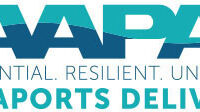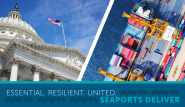Keeping Costs in Check
 ISTOCK.COM/KALI9
ISTOCK.COM/KALI9
It’s the type of headline no presidential administration wants to see, especially in a pivotal midterm election year.
On June 17, Politico published an article entitled “Biden’s incredible shrinking infrastructure plan,” detailing how the highest inflation rates in four decades were shaving billions in value off the president’s signature legislative achievement.
Inflation checked in at 8.2% in September, its seventh consecutive month at 8% or higher, according to the U.S. Bureau of Labor Statistics. Fueled by lingering supply chain issues, the zero-COVID policy affecting Chinese manufacturing, rising wages stemming from a labor shortage, OPEC’s planned reduction in oil output and Russia’s war in Ukraine, inflation showed few signs of abating heading into the winter.
High inflation is also throwing cold water on some of the plans port authorities had considered following passage of the $1 trillion bipartisan infrastructure bill in 2021. The legislation authorized $550 billion in new spending over five years, including $17 billion for port infrastructure, along with sizeable investments in roads and bridges, passenger and freight rail, airports, electric vehicles and other projects.
But a dearth of skilled labor and high costs for construction materials are threatening to blunt the impact of those investments. In October, Turner Construction Co. announced that the Turner Building Cost Index had increased to a reading of 1,311 in the third quarter, up 2.18% from the prior quarter and an 8.6% bump from the third quarter in 2021.
The cost index, maintained by New York City-based Turner, the country’s largest construction firm by revenue, measures costs in the U.S. nonresidential building construction market. The industry is “experiencing a robust market, with numerous mega-jobs,” according to Attilio Rivetti, the Turner vice president responsible for compiling the cost index.
In this case, good news for the construction industry is bad news for major clients such as port authorities and state agencies. As inflation drives costs higher, some states are canceling or delaying major projects, Politico reported. Meanwhile, the shortage of skilled labor is allowing contractors “to be more selective in the projects they pursue,” Rivetti said in a statement.
Amid a building boom, contractors can choose only the most lucrative projects, pushing costs higher still. That factor, combined with high costs for building materials, amounts to a powerful one-two punch forcing public agencies to scale back their infrastructure plans.
“Wages are increasing to attract more labor into the industry and to incentivize skilled labor to travel to meet project needs,” Rivetti said. “Material lead times continue to impact pricing. A focused and strategic approach to procurement that engages contractors, designers, suppliers, manufacturers and clients reduces the risk of price escalation and produces the most competitive results for our clients.”
After spiking in 2021, prices for key materials such as concrete, steel, lumber and diesel fuel retreated in the second half of 2022. With rising interest rates cooling the housing market, costs for building materials are likely to dip further in 2023, according to John Burns Real Estate Consulting, though a drop to pre-pandemic levels seems unlikely anytime soon.
“Building-material demand will almost certainly decline next year at the same time that supply is finally catching up to demand,” the firm wrote in a September blog post.
Remember to Go Local
Even assuming some price relief, port authorities and their partners would do well to follow Rivetti’s advice about procurement. Mike Wychocki, chief marketing officer for Chicago-based EagleRail Container Logistics, said AAPA members should “get that EPC food chain engaged early on if you want to get a better, tighter cost estimate.”
Engineering, procurement and construction (EPC) contracts are also known as turnkey contracts because the EPC contractor typically is expected to deliver a project to an owner ready to use. EPC contractors generally are responsible for designing and engineering a project, procuring all necessary equipment and materials and building the facility within a specified timeframe and at a guaranteed price.

In some cases, regional differences in pricing could be significant enough to affect a project’s scope of work or even its feasibility, said Wychocki, who formerly served as EagleRail’s chief executive and chairman. Consequently, “it behooves you to get the local EPC food chain involved rather than just relying on amalgamated, generic global pricing,” he said. “You want to use very specific regional pricing for EPC.”
EagleRail has met with more than 70 port authorities and agencies to promote its automated, fully electric overhead container shuttle system, Wychocki said. The company says its system can sharply increase terminal slot capacity and throughput while reducing energy consumption and greenhouse-gas emissions by eliminating diesel trucks.
In deciding whether to install EagleRail’s system, ports often compare its costs and benefits with those of building dedicated truck bridges or flyover roads that would enable trucks to bypass dense urban traffic, Wychocki said. Without accurate data on local pricing, it’s difficult for ports to compare several different solutions and make an informed decision.
EagleRail has been affected by the fluctuating price of steel, a major component in its system, Wychocki said. The company can roughly estimate a project’s cost using national pricing averages, but since building materials account for 50% to 60% of that cost, local pricing provides a more accurate picture, he said.

“When someone’s considering a large infrastructure project, it’s important to get local civil and structural people involved right away to determine if it’s affordable,” Wychocki said.
“Another consideration is regional safety standards regarding critical items like foundation stability, earthquakes, wind shear, pedestrian crossings and traffic crossings,” he added. “There are a lot of mandates and regulations, and they can vary greatly from region to region, and we need to take that into consideration when trying to price out a project.”
Local regulations surrounding eminent domain and access also are important given that most ports are situated near urban centers that may constrain expansion plans. EagleRail’s system typically runs alongside existing infrastructure such as roadways or railroads, “but if we have to go next to a neighborhood, it’s good early on to determine what the situation is legally if we have to operate near buildings or cross a road,” Wychocki said.
Planning and Preparation
To get the most out of their infrastructure dollars, it’s vital for port authorities to be thorough in their planning and to be flexible to the extent possible, according to Vanta Coda II, CEO of the Ports of Indiana.
In August, the agency launched an EV demonstration program at its Burns Harbor port, making heavy-duty trucks, yard jockeys and forklifts available to port operators, businesses and trucking companies. The program is part of the Ports of Indiana’s goal to become greener and more sustainable, Coda said.
Two months earlier, the agency marked the completion of $24 million in infrastructure projects at its Jeffersonville port, including a four-mile expansion of the port’s existing 11-mile rail network. The Ports of Indiana had received a $10 million Transportation Investment Generating Economic Recovery (TIGER) grant in 2015, and the application process left the agency better prepared to compete for newly available grants, Coda said.

“I think we’re ahead of the game because of that experience,” he said. “It’s all about the basics of good project design and planning, and really concentrating on what we need to do upfront. That’s the foundational piece of the work. We want to understand what’s possible before we go out and commit a lot of resources to a project.”
The EV pilot was launched after the Ports of Indiana had used a state grant to conduct a “very in-depth study” examining the energy needs of the port and its customers, Coda said. The report is helping the agency to form a robust strategy around renewable energy. Possible sites for solar-energy installations and EV fastcharging stations have been identified, and the agency plans to put up a weather mast to gauge the feasibility of wind power onsite, Coda said.
“The study was designed to answer the question, ‘What do the next 50 years look like?’,” he said. “The pilot is just a starting point. We’ve got a couple of different balls in the air from that study, which is really what you want when you’re spending grant dollars — to have real outcomes.”
As federal dollars flow into major projects, AAPA members, state departments of transportation and other organizations will be “chasing the same pool of talent and resources,” creating a “natural environment for inflation,” Coda said. Given that reality, the Ports of Indiana is looking at “moving projects out longer” to give contractors more flexibility, he added.
“To think that all these projects could be done in a five-year period is unrealistic because we’re all chasing the same contractors and engineers,” Coda said. “What I hear from construction companies is that the longer the lead time that we can give them, the better off we’re going to be in terms of saving money. There’s a culture everywhere of, ‘I need it now.’ Well, you just can’t afford to do that anymore. You need to not have artificial time horizons.”

Through extensive planning, port authorities can limit their change orders, which are prime drivers of construction cost overruns, Coda said. Likewise, they can determine whether there’s any flexibility in the mix of construction materials to be used. With some materials in short supply, costly project delays are more likely if only one type of product will do, he said.
“I’m not sure anyone will be completely successful in terms of inflation avoidance, but I think we can be more thoughtful in leveraging the dollars that we do have,” Coda said. “Sometimes projects aren’t always deeply rooted in due diligence.”
To help it plan effectively, the Ports of Indiana maintains a roster of experienced consultants, preferring highly specialized firms over those that claim to be jacks of all trades, Coda said. The agency has different consultants for areas such as geotechnical engineering, environmental issues, permitting, maintaining railroads, dock walls and heavy-haul roadways, for example.
That approach enables the Ports of Indiana to streamline some aspects of its planning because those firms already are familiar with its facilities and culture, Coda said. Eliminating the “baseline work” of familiarizing a consultant with a new client can save significant time and money, he added.
“You’re not paying that 20% learning-curve tax that you would when you’re starting with somebody new,” Coda said. “Our first question to consultants is, ‘What do you excel at? What makes your firm unique in your area?’”




